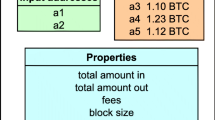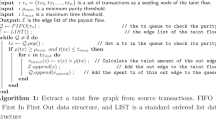Abstract
With the popularity of cryptocurrencies and the remarkable development of blockchain technology, decentralized applications emerged as a revolutionary force for the Internet. Meanwhile, decentralized applications have also attracted intense attention from the online gambling community, with more and more decentralized gambling platforms created through the help of smart contracts. Compared with conventional gambling platforms, decentralized gambling has transparent rules and a low participation threshold, attracting a substantial number of gamblers. In order to discover gambling behaviors and identify the contracts and addresses involved in gambling, we propose a tool termed ETHGamDet. The tool is able to automatically detect the smart contracts and addresses involved in gambling by scrutinizing the smart contract code and address transaction records. Interestingly, we present a novel LightGBM model with memory components, which possesses the ability to learn from its own misclassifications. As a side contribution, we construct and release a large-scale gambling dataset at https://github.com/AwesomeHuang/Bitcoin-Gambling-Dataset to facilitate future research in this field. Empirically, ETHGamDet achieves a F1-score of 0.72 and 0.89 in address classification and contract classification respectively, and offers novel and interesting insights.






Similar content being viewed by others
Data Availability
The datasets analyzed during the current study are available in the GitHub repository [25], https://github.com/AwesomeHuang/Bitcoin-Gambling-Dataset.
References
(2022) Degens - the ethereum betting exchange. Website, https://degens.com/
(2022) Dicether. Website, https://dicether.com/
Akcora CG, Li Y, Gel YR, et al (2020) Bitcoinheist: topological data analysis for ransomware prediction on the bitcoin blockchain. In: Proceedings of the twenty-ninth international joint conference on artificial intelligence
Albert E, Gordillo P, Livshits B, et al (2018) Ethir: a framework for high-level analysis of ethereum bytecode. In: International symposium on automated technology for verification and analysis, Springer, pp 513–520
Ante L, Fiedler I, Strehle E (2021) The impact of transparent money flows: Effects of stablecoin transfers on the returns and trading volume of bitcoin. Technological Forecasting and Social Change 170(120):851
Atzei N, Bartoletti M, Cimoli T (2017) A survey of attacks on ethereum smart contracts (sok). In: International conference on principles of security and trust, Springer, pp 164–186
Ayed AB (2017) A conceptual secure blockchain-based electronic voting system. Int J Network Sec Appl 9(3):01–09
Bhargavan K, Delignat-Lavaud A, Fournet C, et al (2016) Formal verification of smart contracts: Short paper. In: Proceedings of the 2016 ACM workshop on programming languages and analysis for security, pp 91–96
Brent L, Jurisevic A, Kong M, et al (2018) Vandal: a scalable security analysis framework for smart contracts. arXiv preprint arXiv:1809.03981
Broadhurst R, Lord D, Maxim D, et al (2018) Malware trends on ‘darknet’crypto-markets: research review. Available at SSRN 3226758
Campbell-Verduyn M (2018) Bitcoin, crypto-coins, and global anti-money laundering governance. Crime, Law and Social Change 69(2):283–305
Chen T, He T, Benesty M et al (2015) Xgboost: extreme gradient boosting. R package version 04-2 1(4):1–4
Chen T, Li X, Luo X, et al (2017) Under-optimized smart contracts devour your money. In: 2017 IEEE 24th international conference on software analysis, evolution and reengineering (SANER), IEEE, pp 442–446
Chen W, Zheng Z, Cui J, et al (2018) Detecting ponzi schemes on ethereum: towards healthier blockchain technology. In: Proceedings of the 2018 world wide web conference, pp 1409–1418
Chen W, Wu J, Zheng Z, et al (2019) Market manipulation of bitcoin: Evidence from mining the mt. gox transaction network. In: IEEE INFOCOM 2019-IEEE conference on computer communications, IEEE, pp 964–972
Chirtoaca D, Ellul J, Azzopardi G (2020) A framework for creating deployable smart contracts for non-fungible tokens on the ethereum blockchain. In: 2020 IEEE international conference on decentralized applications and infrastructures (DAPPS), IEEE, pp 100–105
Er-Rajy L, El Kiram My A, El Ghazouani M et al (2017) Blockchain: Bitcoin wallet cryptography security, challenges and countermeasures. Journal of Internet Banking and Commerce 22(3):1–29
Feng Q, He D, Zeadally S et al (2019) A survey on privacy protection in blockchain system. Journal of Network and Computer Applications 126:45–58
Friedman JH (2001) Greedy function approximation: a gradient boosting machine. Ann Stat pp 1189–1232
Fu Y, Ren M, Ma F, et al (2019) Evmfuzzer: detect evm vulnerabilities via fuzz testing. In: Proceedings of the 2019 27th ACM joint meeting on European software engineering conference and symposium on the foundations of software engineering, pp 1110–1114
Grech N, Kong M, Jurisevic A et al (2018) Madmax: surviving out-of-gas conditions in ethereum smart contracts. In: Proceedings of the ACM on programming languages 2(OOPSLA):1–27
Grech N, Brent L, Scholz B, et al (2019) Gigahorse: thorough, declarative decompilation of smart contracts. In: 2019 IEEE/ACM 41st international conference on software engineering (ICSE), IEEE, pp 1176–1186
Guo Y, Liang C (2016) Blockchain application and outlook in the banking industry. Financial innovation 2(1):1–12
Hildenbrandt E, Saxena M, Rodrigues N, et al (2018) Kevm: a complete formal semantics of the ethereum virtual machine. In: 2018 IEEE 31st computer security foundations symposium (CSF), IEEE, pp 204–217
Huang Z (2022) Bitcoin gambling dataset. Website, https://github.com/AwesomeHuang/Bitcoin-Gambling-Dataset
Kalra S, Goel S, Dhawan M, et al (2018) Zeus: analyzing safety of smart contracts. In: Ndss, pp 1–12
Ke G, Meng Q, Finley T, et al (2017) Lightgbm: a highly efficient gradient boosting decision tree. Adv Neural Inf Process Syst 30
Lee C, Maharjan S, Ko K, et al (2019) Toward detecting illegal transactions on bitcoin using machine-learning methods. In: International conference on blockchain and trustworthy systems, Springer, pp 520–533
Li P, Xu H, Ma T (2021) An efficient identity tracing scheme for blockchain-based systems. Information Sciences 561:130–140
Liu J, Liu Z (2019) A survey on security verification of blockchain smart contracts. IEEE Access 7:77894–77904
Liu Z, Qian P, Wang X, et al (2021) Smart contract vulnerability detection: from pure neural network to interpretable graph feature and expert pattern fusion. arXiv preprint arXiv:2106.09282
Liu Z, Qian P, Wang X, et al (2021) Combining graph neural networks with expert knowledge for smart contract vulnerability detection. IEEE Trans Knowl Data Eng
Luu L, Chu DH, Olickel H, et al (2016) Making smart contracts smarter. In: Proceedings of the 2016 ACM SIGSAC conference on computer and communications security, pp 254–269
Macrinici D, Cartofeanu C, Gao S (2018) Smart contract applications within blockchain technology: A systematic mapping study. Telematics and Informatics 35(8):2337–2354
Mehar MI, Shier CL, Giambattista A et al (2019) Understanding a revolutionary and flawed grand experiment in blockchain: the dao attack. Journal of Cases on Information Technology (JCIT) 21(1):19–32
Miller JJ (2013) Graph database applications and concepts with neo4j. In: Proceedings of the southern association for information systems conference, Atlanta, GA, USA
Mohanta BK, Panda SS, Jena D (2018) An overview of smart contract and use cases in blockchain technology. In: 2018 9th international conference on computing, communication and networking technologies (ICCCNT), IEEE, pp 1–4
Morishima S (2021) Scalable anomaly detection in blockchain using graphics processing unit. Computers & Electrical Engineering 92(107):087
Norta A (2016) Designing a smart-contract application layer for transacting decentralized autonomous organizations. In: International conference on advances in computing and data sciences, Springer, pp 595–604
Qian P, Liu Z, Wang X, et al (2019) Digital resource rights confirmation and infringement tracking based on smart contracts. In: 2019 IEEE 6th international conference on cloud computing and intelligence systems (CCIS), IEEE, pp 62–67
Scholten OJ, Zendle D, Walker JA (2020) Inside the decentralised casino: A longitudinal study of actual cryptocurrency gambling transactions. PloS one 15(10):e0240,693
Suiche M (2017) Porosity: a decompiler for blockchain-based smart contracts bytecode. DEF con 25(11)
Szabo N, et al (1994) Smart contracts
Team E (2017) Etherscan: The ethereum block explorer. https://etherscan.io
Tsankov P, Dan A, Drachsler-Cohen D, et al (2018) Securify: practical security analysis of smart contracts. In: Proceedings of the 2018 ACM SIGSAC conference on computer and communications security, pp 67–82
Victor F, Lüders BK (2019) Measuring ethereum-based erc20 token networks. In: International conference on financial cryptography and data security, Springer, pp 113–129
Warren W, Bandeali A (2017) 0x: An open protocol for decentralized exchange on the ethereum blockchain. https://githubcom/0xProject/whitepaper, pp 04–18
Webber J (2012) A programmatic introduction to neo4j. In: Proceedings of the 3rd annual conference on Systems, programming, and applications: software for humanity, pp 217–218
Wood G (2014) Ethereum yellow paper. Internet: https://githubcom/ethereum/yellowpaper, [Oct 30, 2018] p 30
Wu J, Yuan Q, Lin D, et al (2020) Who are the phishers? phishing scam detection on ethereum via network embedding. IEEE Trans Syst Man Cybern Syst
Yan C, Zhang C, Lu Z et al (2022) Blockchain abnormal behavior awareness methods: a survey. Cybersecurity 5(1):1–27
Zheng Z, Xie S, Dai HN et al (2018) Blockchain challenges and opportunities: A survey. Int J Web Grid Serv 14(4):352–375
Zhou Y, Kumar D, Bakshi S, et al (2018) Erays: reverse engineering ethereum’s opaque smart contracts. In: 27th USENIX security symposium (USENIX Security 18), pp 1371–1385
Zhuang Y, Liu Z, Qian P, et al (2020) Smart contract vulnerability detection using graph neural network. In: IJCAI, pp 3283–3290
Zichichi M, Contu M, Ferretti S, et al (2019) Likestarter: a smart-contract based social dao for crowdfunding. In: IEEE INFOCOM 2019-IEEE conference on computer communications workshops (INFOCOM WKSHPS), IEEE, pp 313–318
Acknowledgements
This work was supported in part by the National Key R &D Program of China (2021YFB2700500); in part by the National Natural Science Foundation of China (No. 61902348); and in part by the Key R &D Program of Zhejiang Province (No. 2021C01104).
Author information
Authors and Affiliations
Corresponding author
Ethics declarations
Conflict of interest
All the authors have checked the manuscript and have agreed to the submission in International Journal of Multimedia Information Retrieval. There is no conflict of interest.
Additional information
Publisher's Note
Springer Nature remains neutral with regard to jurisdictional claims in published maps and institutional affiliations.
Rights and permissions
Springer Nature or its licensor (e.g. a society or other partner) holds exclusive rights to this article under a publishing agreement with the author(s) or other rightsholder(s); author self-archiving of the accepted manuscript version of this article is solely governed by the terms of such publishing agreement and applicable law.
About this article
Cite this article
Huang, Z., Liu, Z., Chen, J. et al. Who is gambling? Finding cryptocurrency gamblers using multi-modal retrieval methods. Int J Multimed Info Retr 11, 539–551 (2022). https://doi.org/10.1007/s13735-022-00264-3
Received:
Revised:
Accepted:
Published:
Issue Date:
DOI: https://doi.org/10.1007/s13735-022-00264-3




